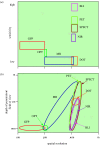Molecular imaging perspectives
- PMID: 16849174
- PMCID: PMC1629073
- DOI: 10.1098/rsif.2005.0040
Molecular imaging perspectives
Abstract
Molecular imaging is an emerging technology at the life science/physical science interface which is set to revolutionize our understanding and treatment of disease. The tools of molecular imaging are the imaging modalities and their corresponding contrast agents. These facilitate interaction with a biological target at a molecular level in a number of ways. The diverse nature of molecular imaging requires knowledge from both the life and physical sciences for its successful development and implementation. The aim of this review is to introduce the subject of molecular imaging from both life science and physical science perspectives. However, we will restrict our coverage to the prominent in vivo molecular imaging modalities of magnetic resonance imaging, optical imaging and nuclear imaging. The physical basis of these imaging modalities, the use of contrast agents and the imaging parameters of sensitivity, temporal resolution and spatial resolution are described. Then, the specificity of contrast agents for targeting and sensing molecular events, and some applications of molecular imaging in biology and medicine are given. Finally, the diverse nature of molecular imaging and its reliance on interdisciplinary collaboration is discussed.
Figures
Similar articles
-
[New perspectives of imaging techniques in islet research].Dtsch Med Wochenschr. 2011 May;136(21):1130-4. doi: 10.1055/s-0031-1280525. Epub 2011 May 17. Dtsch Med Wochenschr. 2011. PMID: 21590635 Review. German. No abstract available.
-
[Magnetic resonance tomography and hybrid imaging in rheumatology].Z Rheumatol. 2013 Mar;72(2):137-44. doi: 10.1007/s00393-012-1068-7. Z Rheumatol. 2013. PMID: 23446460 Review. German.
-
Discrepancies and priorities in staging and restaging malignant lymphoma by SPET, SPET/CT, PET/CT and PET/MRI.Hell J Nucl Med. 2013 Sep-Dec;16(3):223-9. doi: 10.1967/s002449910098. Epub 2013 Oct 2. Hell J Nucl Med. 2013. PMID: 24137584 Review.
-
Molecular probes for the in vivo imaging of cancer.Mol Biosyst. 2009 Nov;5(11):1279-91. doi: 10.1039/b911307j. Epub 2009 Aug 19. Mol Biosyst. 2009. PMID: 19823742 Free PMC article. Review.
-
Multimodality cardiovascular molecular imaging technology.J Nucl Med. 2010 May 1;51 Suppl 1(Suppl 1):38S-50S. doi: 10.2967/jnumed.109.068155. J Nucl Med. 2010. PMID: 20457794 Free PMC article. Review.
Cited by
-
Multimodal imaging of pancreatic beta cells in vivo by targeting transmembrane protein 27 (TMEM27).Diabetologia. 2012 Sep;55(9):2407-16. doi: 10.1007/s00125-012-2605-2. Epub 2012 Jul 13. Diabetologia. 2012. PMID: 22790173 Free PMC article.
-
Biodistribution of extracellular vesicles following administration into animals: A systematic review.J Extracell Vesicles. 2021 Jun;10(8):e12085. doi: 10.1002/jev2.12085. Epub 2021 Jun 24. J Extracell Vesicles. 2021. PMID: 34194679 Free PMC article.
-
Small bowel imaging of inflammatory bowel disease.World J Radiol. 2015 Aug 28;7(8):198-201. doi: 10.4329/wjr.v7.i8.198. World J Radiol. 2015. PMID: 26339463 Free PMC article.
-
Peptide-nanoparticle conjugates: a next generation of diagnostic and therapeutic platforms?Nano Converg. 2018 Dec 12;5(1):38. doi: 10.1186/s40580-018-0170-1. Nano Converg. 2018. PMID: 30539365 Free PMC article. Review.
-
Multimodal molecular imaging evaluation for early diagnosis and prognosis of cholangiocarcinoma.Insights Imaging. 2022 Jan 20;13(1):10. doi: 10.1186/s13244-021-01147-7. Insights Imaging. 2022. PMID: 35050416 Free PMC article. Review.
References
-
- Aime S, Cabella C, Colombatto S, Geninatti Crich S, Gianolio E, Maggioni F. Insights into the use of paramagnetic Gd(III) complexes in MR-molecular imaging investigations. J. Magn. Reson. Imaging. 2002;16:394–406. - PubMed
-
- Artemov D. Molecular magnetic resonance imaging with targeted contrast agents. J. Cell. Biochem. 2003;90:518–524. - PubMed
Publication types
MeSH terms
Substances
LinkOut - more resources
Full Text Sources
Other Literature Sources
Medical


